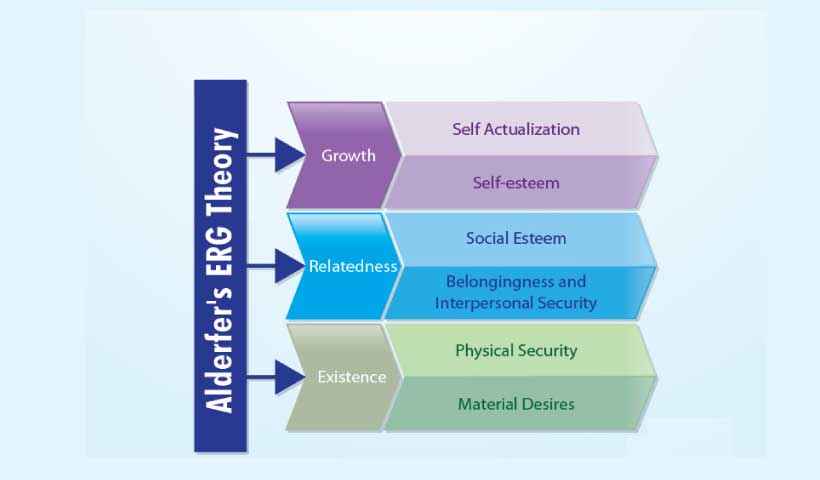The ERG theory of motivation was developed by Clayton Alderfer in the 1960s as an extension of Maslow's hierarchy of needs. The theory proposes that there are three core needs that motivate individuals: existence, relatedness, and growth.
1. Existence needs: These are the most basic needs and include physiological and safety needs such as food, shelter, and security.
2. Relatedness needs: These needs involve social interaction and relationships with others. They include the need for belongingness, love, and affection.
3. Growth needs: These needs involve personal development and self-actualization. They include the need for self-esteem, personal growth, and achievement.
According to Alderfer's theory, individuals may experience frustration when their needs are not being met. However, unlike Maslow's hierarchy, Alderfer's theory allows for movement between the different levels of needs. For example, if an individual's growth needs are not being met, they may shift their focus back to their relatedness or existence needs.
Alderfer's theory has been used to explain motivation in the workplace, as well as in other contexts such as education and healthcare.
Importance of ERG Theory
The ERG theory is an alternative to Maslow's hierarchy of needs and describes three basic needs that motivate human behavior: existence, relatedness, and growth.
The importance of ERG theory lies in its ability to help managers understand and address the needs and motivations of their employees. By recognizing that employees have different levels of needs, managers can design work environments and incentive programs that address those needs appropriately.
Additionally, ERG theory can help managers identify the causes of employee dissatisfaction and take corrective actions. For example, if an employee is dissatisfied because they feel their growth needs are not being met, the manager can provide opportunities for professional development and advancement.
ERG theory also highlights the importance of job design and social relationships in employee motivation. Managers can use this insight to create jobs that are challenging and meaningful, and to foster a positive work environment that promotes teamwork and collaboration.
Overall, ERG theory provides a valuable framework for understanding employee motivation and designing effective workplace policies and practices. By taking into account the different needs and motivations of employees, managers can create a more engaged and productive workforce.
Criticism of ERG theory
ERG theory focuses on three basic needs of individuals: existence, relatedness, and growth. While the theory has some merits, it has also faced criticism. Here are a few criticisms of the ERG theory:
1. Lack of empirical evidence: Critics argue that there is a lack of empirical evidence to support the theory. While Alderfer's model seems plausible, there is little scientific research to back up its claims. Empirical studies that have been conducted to test ERG theory have produced mixed results, making it difficult to determine the theory's validity.
2. Ambiguity of the concept: Some critics have argued that the concept of ERG theory is ambiguous and difficult to define. For example, the distinction between relatedness and growth needs is not always clear, which can lead to confusion and inconsistencies in application.
3. Lack of practicality: ERG theory has been criticized for its lack of practicality in real-world settings. The theory does not offer clear guidelines on how to apply its concepts in the workplace, making it difficult for managers to use it as a tool for motivation and employee engagement.
4. Oversimplification of motivation: ERG theory oversimplifies motivation by reducing it to three basic needs. Critics argue that motivation is a complex and multifaceted concept that cannot be fully explained by a simple three-factor model.
5. Lack of cultural sensitivity: ERG theory has been criticized for its lack of cultural sensitivity. The theory was developed in a Western context and may not be applicable to other cultures with different values and beliefs.
Overall, while ERG theory has some useful insights into motivation, it is not without its limitations and criticisms.
ERG theory vs Maslow hierarchy of needs
ERG theory and Maslow's Hierarchy of Needs are both theories that attempt to explain the motivation behind human behavior. However, there are some differences between the two.
ERG theory is based on three core needs: existence, relatedness, and growth. The theory suggests that these three needs are the driving force behind human behavior, and that they are arranged in a flexible hierarchy. Unlike Maslow's hierarchy, which suggests that needs must be satisfied in a specific order, ERG theory suggests that multiple needs can be active at the same time and that individuals can move up and down the hierarchy depending on their current circumstances.

Maslow's Hierarchy of Needs, developed by Abraham Maslow, is a motivational theory that suggests that human needs are arranged in a hierarchical order, with basic physiological and safety needs at the bottom, followed by belongingness and love needs, esteem needs, and finally self-actualization needs at the top. The theory suggests that individuals must satisfy lower level needs before they can move up to higher level needs, and that self-actualization is the ultimate goal of human behavior.
Overall, both ERG theory and Maslow's Hierarchy of Needs provide valuable insights into human motivation and behavior. However, ERG theory is more flexible and allows for individual differences and changing circumstances, while Maslow's Hierarchy is more prescriptive in terms of the order in which needs must be satisfied.
Alderfer’s ERG theory of motivation examples
Alderfer's ERG theory of motivation is a human needs theory that proposes three basic needs: Existence, Relatedness, and Growth. According to this theory, these three needs are hierarchical, but unlike Maslow's Hierarchy of Needs, Alderfer's theory allows for movement back and forth between levels, as well as simultaneous satisfaction of multiple needs.
Here are some examples of how Alderfer's ERG theory of motivation can be applied in different contexts:
1. Existence needs: These are the basic needs that an individual needs to survive, such as food, water, shelter, and a safe working environment. Examples of existence needs include:
• An employee may prioritize their salary and benefits package as it allows them to fulfill their basic needs.
• An entrepreneur may focus on creating a stable business structure, financial security, and reliable resources to satisfy their existence needs.
2. Relatedness needs: These are the social needs that an individual needs to maintain relationships with others, including family, friends, colleagues, and society. Examples of relatedness needs include:
• An employee may prioritize building relationships with their coworkers and managers to feel socially connected at work and increase their job satisfaction.
• A volunteer may prioritize working for a social cause to feel connected to their community and society.
3. Growth needs: These are the higher-order needs that an individual needs to fulfill their potential, such as personal development, creativity, and learning.
Examples of growth needs include:
• An employee may prioritize attending training and development programs, seeking new challenges and opportunities for personal growth.
• A student may prioritize their education to achieve personal and professional growth.
In summary, Alderfer's ERG theory of motivation is a useful framework for understanding the different needs that drive human behavior and can be applied to various settings, including the workplace, education, and personal development.








